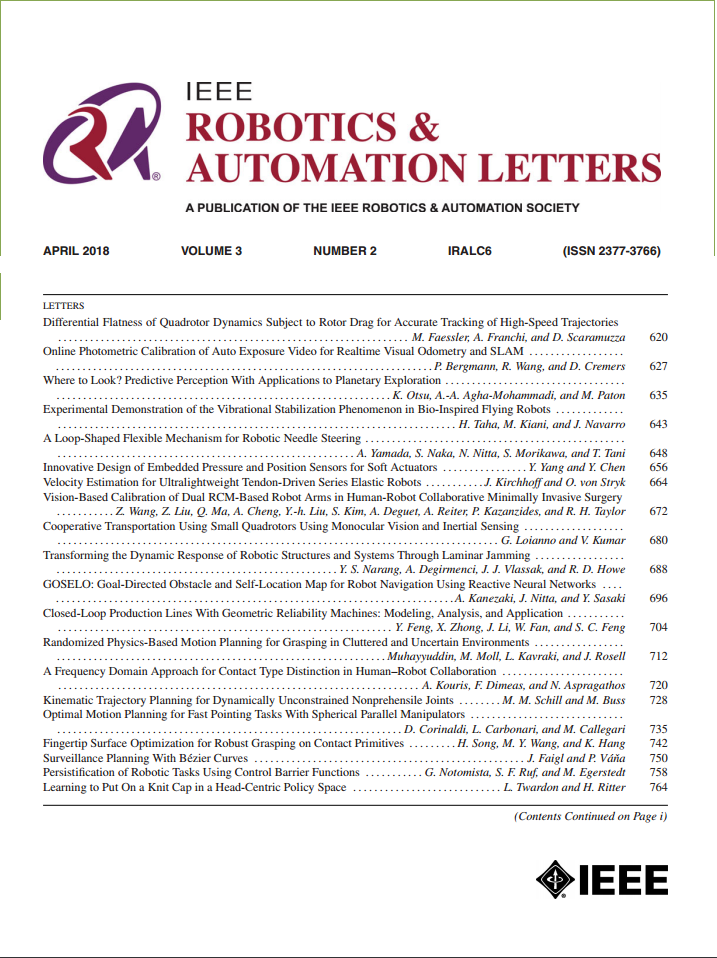Uncertain Pushing Adaptive Coordinated Control for the Human-Exoskeleton-Walker System
IF 4.6
2区 计算机科学
Q2 ROBOTICS
引用次数: 0
Abstract
Lower Limb Exoskeletons are potential in the gait training for patients with gait disorders. For patients in the early rehabilitation stages with weak upper limb strength, it is challenge to keep balance by themselves only. A mobile robotic walker is helpful to maintain the walking balance, with the help of a physician pushing behind to keep a forward walking associated with the exoskeleton. However, since the gait patterns are varying with different training tasks, how to ensure a coordinated movement between the exoskeleton and the mobile robotic walker is challenge, especially with the uncertain pushing applied by the physician. In this letter, the Uncertain Pushing Adaptive Coordinated Control (UP-ACC) approach is proposed to solve the problem, which consists of two contributions. Based on the decoupled simplified dynamics, the center of mass trajectories and footstep placements are generated through linear model predictive control. In addition, the optimal footstep placement is used for the human-like gait planning by introducing the phases of heel-strike and toe-off. The proposed method has been verified in the robot simulation platform CoppeliaSim, and the experimental results indicate its effectiveness in generating coordinated motion and human-like gait patterns for the human-exoskeleton-walker system with the external pushing from 0 to 150 N and walking speed from 0.2 m/s to 0.6 m/s.人-外骨骼-行走系统的不确定推力自适应协调控制
下肢外骨骼在步态障碍患者的步态训练中具有潜在的应用价值。对于康复早期上肢力量较弱的患者,仅靠自己保持平衡是一项挑战。移动机器人助行器有助于保持行走平衡,在医生的帮助下,在外骨骼的帮助下保持向前行走。然而,由于步态模式随训练任务的不同而变化,如何确保外骨骼和移动机器人行走器之间的协调运动是一个挑战,特别是在医生施加不确定的推动下。本文提出了不确定推进自适应协调控制(UP-ACC)方法来解决该问题,该方法由两个部分组成。在解耦简化动力学的基础上,通过线性模型预测控制生成质心轨迹和脚印位置。此外,通过引入足跟撞击和脚尖脱落的阶段,将最佳的脚掌位置用于仿人步态规划。该方法在CoppeliaSim机器人仿真平台上进行了验证,实验结果表明,该方法可以有效地生成外推力为0 ~ 150n、步行速度为0.2 ~ 0.6 m/s的人体外骨骼-步行系统的协调运动和仿人步态模式。
本文章由计算机程序翻译,如有差异,请以英文原文为准。
求助全文
约1分钟内获得全文
求助全文
来源期刊

IEEE Robotics and Automation Letters
Computer Science-Computer Science Applications
CiteScore
9.60
自引率
15.40%
发文量
1428
期刊介绍:
The scope of this journal is to publish peer-reviewed articles that provide a timely and concise account of innovative research ideas and application results, reporting significant theoretical findings and application case studies in areas of robotics and automation.
 求助内容:
求助内容: 应助结果提醒方式:
应助结果提醒方式:


